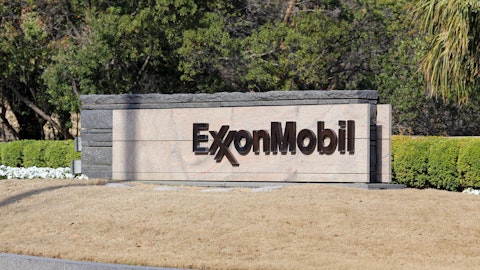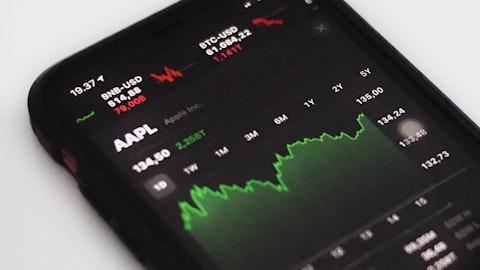In this article, we discuss the top 5 stock picks of Mark Kleiman’s Factorial Partners. If you want our detailed analysis of Factorial Partners’ history, investment philosophy, and hedge fund performance, go directly to Top 10 Stock Picks of Mark Kleiman’s Factorial Partners.
5. Pfizer Inc. (NYSE:PFE)
Factorial Partners’ Stake Value: $3,602,000
Percentage of Factorial Partners’ 13F portfolio: 2.92%
Number of Q2 Hedge Fund Holders: 71
Pfizer Inc. (NYSE:PFE) develops, manufactures, markets, distributes, and sells biopharmaceutical products around the world. Factorial Partners added Pfizer Inc. (NYSE:PFE) to its portfolio during Q2, acquiring 68,700 shares worth $3.6 million, representing 2.92% of its total holdings.
On July 8, Morgan Stanley analyst Terence Flynn reduced the firm’s price target for Pfizer Inc. (NYSE:PFE) from $52 to $49 after modifying projections ahead of the company’s upcoming Q2 earnings report, while maintaining an ‘Equal Weight’ rating on the shares. Companies that can provide revenue growth in the second half of the decade, according to Flynn, are best positioned among the group, and he expects biopharma sales to remain resilient even if economic activity slows.
Pfizer Inc. (NYSE:PFE) declared a $0.40 per share quarterly dividend on June 23, payable on September 6 to shareholders of record as of July 29. Pfizer Inc. (NYSE:PFE) shares deliver a dividend yield of 3.21% as of August 11.
According to Insider Monkey’s Q2 data, 71 hedge funds were long Pfizer Inc. (NYSE:PFE), with combined stakes worth $2.8 billion. Kahn Brothers is a major stakeholder of the company, with 1.04 million shares worth $54.9 million.
Here is what ClearBridge Investments Value Equity Strategy had to say about Pfizer Inc. (NYSE:PFE) in its Q4 2021 investor letter:
“While the level of general turnover abated as we progressed through 2021, it remained high in one area: post-COVID-19 recovery plays. The concept behind this investment thesis was, and still is, straightforward: with the advent of effective vaccines, the path from pandemic to endemic is just a matter of time. As this transition occurs, the estimated excess savings of over $2 trillion built up on U.S. consumer balance sheets will unlock dramatic pent-up demand for experiences, especially global travel. This investment case seemed especially compelling when the Pfizer vaccine positively surprised markets in November 2020. As a result, we made post-COVID-19 stocks (which were trading well below our estimate of recovery value) a sizable theme within the portfolio. We understood this to be a more aggressive tilt in positioning because it required a major improvement in demand to catalyze fundamentals and drive price toward higher business values. While we accepted that recovery would not be smooth and that it would take time to deploy vaccines both domestically and globally, we decided that recovery was the logical path of least resistance and we were being well compensated for these risks.
What we did not account for, however, was vaccine hesitancy and the risk of further infection waves. As a result, the first variant wave, Delta, was a negative surprise to both the market and our team. When the risk surfaced, we immediately updated our probability-driven models and debated how we should react. The resulting conclusion was that the recovery would be delayed and that we should reduce our exposure quickly, subsequently targeting the most aggressive recovery stocks such as cruise lines. We again acted swiftly and decisively to the positive surprise that Pfizer had delivered a high-efficacy antiviral COVID-19 pill. This pill should greatly reduce COVID-19 severity risks globally, increasing the probability of a global travel recovery in 2022. While this is still true, the emergence of the highly mutated Omicron variant set off another infection wave which spurred us to again act quickly and further reduce our risk exposure. This back-and-forth may sound exhausting, but it highlights our compulsion to act if we determine a surprise has a large enough impact on the probabilities that power our valuation-driven investment cases.”
4. Discover Financial Services (NYSE:DFS)
Factorial Partners’ Stake Value: $3,641,000
Percentage of Factorial Partners’ 13F portfolio: 2.95%
Number of Q2 Hedge Fund Holders: 40
Discover Financial Services (NYSE:DFS) provide digital banking products and services, as well as payment services, in the United States through its subsidiaries. It has two business segments: Digital Banking and Payment Services. Factorial Partners owned 38,500 shares of Discover Financial Services (NYSE:DFS) on June 30, worth $3.6 million, and representing a 2.95% chunk of its 13F portfolio’s weighting.
BMO Capital analyst James Fotheringham reduced his Discover Financial Services’ (NYSE:DFS) price target to $118 from $131 on July 25 and maintained a ‘Market Perform’ rating on the stock. The company reported solid Q2 results with higher revenues, lower costs, and benign credit trends, while raising its 2022 guidance on growth, net interest margins, and net charge-off rates, but all of this was overshadowed by the suspension of share repurchases, the analyst wrote in a research note.
Among the hedge funds tracked by Insider Monkey, 40 were long Discover Financial Services (NYSE:DFS) on June 30, with combined stakes worth $597 million. Ric Dillon’s Diamond Hill Capital is a leading position holder in the company, with 64,850 shares worth $6.1 million.
3. Apple Inc. (NASDAQ:AAPL)
Factorial Partners’ Stake Value: $3,741,000
Percentage of Factorial Partners’ 13F portfolio: 3.04%
Number of Q2 Hedge Fund Holders: 130
Apple Inc. (NASDAQ:AAPL) creates, manufactures, and sells smartphones, personal computers, tablets, wearables, and accessories all over the world. Factorial Partners added Apple Inc. (NASDAQ:AAPL) to its portfolio in Q2 by obtaining 27,360 shares worth $3.7 million, representing 3.04% of the portfolio’s total holdings.
On July 29, Morgan Stanley analyst Erik Woodring said Apple Inc.’s (NASDAQ:AAPL) June quarter results were “better than feared,” as iPhone and Services upside offset Mac and iPad supply constraints and a decline in Wearables. Management’s September quarter guidance for revenues to be up a mid-single digits percentage year-over-year appears “rightfully conservative,” said Woodring, who maintains Apple as his Top Pick with an unchanged $180 price target and ‘Overweight’ rating.
According to Insider Monkey’s data, 130 hedge funds were bullish on Apple Inc. (NASDAQ:AAPL) at the end of Q2, down from 132 funds in the prior quarter. Ken Fisher’s Fisher Asset Management featured as one of the largest stakeholders in the company, with 65.7 million shares worth $8.9 billion.
2. Citigroup Inc. (NYSE:C)
Factorial Partners’ Stake Value: $4,157,000
Percentage of Factorial Partners’ 13F portfolio: 3.37%
Number of Q2 Hedge Fund Holders: 86
Citigroup Inc. (NYSE:C), a diversified financial services holding company, offers a wide range of financial products and services to individuals, businesses, governments, and institutions in North America, Latin America, Asia, Europe, the Middle East, and Africa. As of the end of Q2, Factorial Partners owned 90,400 shares of Citigroup Inc. (NYSE:C) worth around $4.15 million, representing 3.37% of its total 13F holdings.
On July 18, Analyst Chris Kotowski at Oppenheimer raised the firm’s price target on Citigroup Inc. (NYSE:C) to $86 from $81 and maintained an ‘Outperform’ rating on the stock. The analyst noted that while Citigroup Inc.’s (NYSE:C) stock was up 13% on earnings day, it’s still trades at only at 62% of the firm’s $80 tangible book value, and this for a company with a clean balance sheet and non-accruals at 0.5% of loans. That, in his opinion, means that the book is “hard” and could be converted into cash and returned to shareholders over time, even if the returns remain subpar.
According to Insider Monkey’s data, 86 hedge funds were long Citigroup Inc. (NYSE:C) at the end of June 2022, down from 90 funds in the preceding quarter. Kahn Brothers is a leading stakeholder of the company, with roughly 1.11 million shares worth $51.2 billion.
1. The Goldman Sachs Group, Inc. (NYSE:GS)
Factorial Partners’ Stake Value: $4,304,000
Percentage of Factorial Partners’ 13F portfolio: 3.49%
Number of Q2 Hedge Fund Holders: 70
The Goldman Sachs Group, Inc. (NYSE:GS) is a financial institution that offers a variety of financial services to corporations, financial institutions, governments, and individuals around the world. Investment Banking, Global Markets, Asset Management, and Consumer & Wealth Management are its four business segments. Factorial Partners added The Goldman Sachs Group, Inc. (NYSE:GS) to its Q2 portfolio, acquiring 14,490 shares worth around $4.30 million, representing 3.49% of the fund’s total 13F holdings.
On April 14, The Goldman Sachs Group, Inc. (NYSE:GS) declared a $2.00 per share quarterly dividend. The dividend was payable on June 29 to shareholders of record as of June 1. The Goldman Sachs Group, Inc. (NYSE:GS) shares deliver a dividend yield of 2.38% as of August 11.
BMO Capital analyst James Fotheringham reduced the firm’s price target on The Goldman Sachs Group, Inc. (NYSE:GS) to $461 from $475 on July 19, but maintained an ‘Outperform’ rating on the stock. While the company reported an “impressive” revenue-driven beat, the analyst lowered his forward estimates due to higher expected operating and credit costs, according to a research note. Fotheringham adds that in the long run, The Goldman Sachs Group, Inc. (NYSE:GS) can maintain mid-teens RoTCE due to ongoing tailwinds from share gains in core IB/GM franchises, improved profitability of higher-growth adjacencies, and ongoing capital and funding optimization.
Among the hedge funds tracked by Insider Monkey, 70 funds were bullish on The Goldman Sachs Group, Inc. (NYSE:GS) at the end of June 2022, with a collective stake of around $4.62 billion. Ken Fisher’s Fisher Asset Management is a major shareholder of the company, with more than 3.2 million shares worth $976 million.
Here is what Ariel Investments had to say about The Goldman Sachs Group, Inc. (NYSE:GS) in its Q4 2021 investor letter:
“Rising interest rates, after a surprisingly long period of low absolute rates and negative “real” rates, will create a headwind. While there has been much debate about the cause of these low rates, we believe the most important factor has been the $120 billion in monthly federal reserve open market bond purchases and the accumulation of an $8 trillion balance sheet. The former will end, and the latter will shrink. It is not just the Fed that has aggressively purchased bonds, bidding up prices and lowering yields. Bond traders and hedge fund managers have added to positions, confident that being on the same side as the Fed was the wise place to be. Now as the Fed is about to become a seller of bonds rather than a buyer, Wall Street’s “smart money” is likely to follow suit. Against this backdrop, fixed income securities and bond substitutes such as high dividend paying utilities and absolute return hedge funds are substantially overpriced and are not likely to produce attractive returns going forward.
This expectation of a reversion to the mean for interest rates helped 2021 performance, though not as much as we had hoped. The yield on the U.S. 10-year Treasury did indeed increase from +0.92% at the beginning of the year to +1.52% at year-end. An underreported story was the poor performance of bonds last year. The Barclays Aggregate Index declined -1.67% for the year ending December compared to a return of +28.71% for equities as measured by the S&P 500. Interest rates have continued to climb in 2022 with the 10-year Treasury at +1.79% as we go to print. This move higher in rates has contributed to our good, early start to 2022. The Goldman Sachs Group, Inc. (NYSE:GS) jumped +47.59% for the year and +1.73% in the quarter.”
You can also take a look at the 10 Best Websites To Research Stocks and 10 Energy Stocks to Buy Before Winter.





